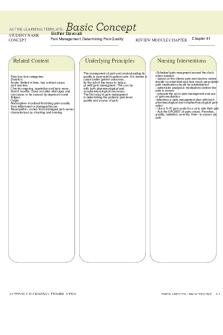ATI - Basic Concept - template PDF

| Title | ATI - Basic Concept - template |
|---|---|
| Author | Claudine Clarin |
| Course | Nursing Fundamentals |
| Institution | West Coast University |
| Pages | 1 |
| File Size | 75.8 KB |
| File Type | |
| Total Downloads | 101 |
| Total Views | 184 |
Summary
template...
Description
ACTIVE LEARNING TEMPLATE:
Basic Concept
Claudine Clarin STUDENT NAME _____________________________________ Client Safety
CONCEPT ______________________________________________________________________________
Related Content
Underlying Principles
(E.G., DELEGATION, LEVELS OF PREVENTION, ADVANCE DIRECTIVES)
Safety and infection control, safe and effective care environment Fall risk assessment is used to find out if a patient has a low, moderate, or high risk of falling. If the assessment shows an increased risk, recommended strategies will be taught in order to reduce, or further prevent the chance of injury. Fall risk assessment: - not performed during admission - failure to perform the assessment will potentially endanger a client, who is moderate or high at fall risk. - without fall risk, the nurse or provider does not know the client’s risk for falls and does not take the proper precautions.
12
REVIEW MODULE CHAPTER ___________
Nursing Interventions WHO? WHEN? WHY? HOW?
Prevention: complete a fallrisk assessment for each client at admission and at regular intervals. Individualize their plans. Make sure to educate them on how to use the call light, and be sure to Textrespond to their call lights at a timely manner.
Use risk assessment tools to evaluate the clients and their environment for their safety. Encourage clients to communicate! (Communicate with them their risk factors and their plan of care).
Use fall-risk bands to help yourself and others identify who is at risk for falls.
Follow protocols for each corresponding situation. Know the facility's disaster plan.
Have adequate lighting, and keep them near the nursing station.
Identify and document incidents (follow facility's policy).
Keep the bed at the lowest position and LOCK THE BRAKES. Keep side rails up (avoid using all 4).
Use equipment after safety inspection.
Keep the floor clean, dry and clutter-free. provide non-skid shoes. Do hourly rounds.
ADOPT QUALITY CARE PRIORITIES....
Similar Free PDFs

ATI - Basic Concept - template
- 1 Pages

ATI - Basic Concept 2 - template
- 1 Pages

Basic Concept form ati
- 1 Pages

Advocacy - ATI Basic Concept
- 1 Pages

Basic Concept 1 - ATI work
- 1 Pages
Popular Institutions
- Tinajero National High School - Annex
- Politeknik Caltex Riau
- Yokohama City University
- SGT University
- University of Al-Qadisiyah
- Divine Word College of Vigan
- Techniek College Rotterdam
- Universidade de Santiago
- Universiti Teknologi MARA Cawangan Johor Kampus Pasir Gudang
- Poltekkes Kemenkes Yogyakarta
- Baguio City National High School
- Colegio san marcos
- preparatoria uno
- Centro de Bachillerato Tecnológico Industrial y de Servicios No. 107
- Dalian Maritime University
- Quang Trung Secondary School
- Colegio Tecnológico en Informática
- Corporación Regional de Educación Superior
- Grupo CEDVA
- Dar Al Uloom University
- Centro de Estudios Preuniversitarios de la Universidad Nacional de Ingeniería
- 上智大学
- Aakash International School, Nuna Majara
- San Felipe Neri Catholic School
- Kang Chiao International School - New Taipei City
- Misamis Occidental National High School
- Institución Educativa Escuela Normal Juan Ladrilleros
- Kolehiyo ng Pantukan
- Batanes State College
- Instituto Continental
- Sekolah Menengah Kejuruan Kesehatan Kaltara (Tarakan)
- Colegio de La Inmaculada Concepcion - Cebu










